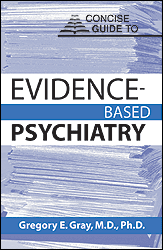|
|
|
| |
 |
|
|

|
-
推薦指數:



|
|
- 內容介紹
|
Concise Guide to Evidence-Based Psychiatry .
by Gray, Gregory E.
2004 · 264 pages · ISBN 1-58562-096-3 · Paperback
Edition 1 ,AMERICAN PSYCHIATRIC PUBLISHING INC
Concise Guide to Evidence-Based Psychiatry (EBP) is a must-have resource for informed decision-making in psychiatric practice today. This single, easy-to-use reference will enable practitioners to find answers to clinical questions, critically appraise articles, and apply the results of their findings to patients.
This practical handbook provides quick access to EBP theories, tools, and methods. Concise Guide to Evidence-Based Psychiatry is a one-stop reference for using the literature to improve patient outcomes. Features include:
Practical—Filled with how-to information, Concise Guide to Evidence-Based Psychiatry outlines the latest techniques for accessing, assessing, and interpreting the literature.
Easy to use—Includes many tables of essential websites for finding reliable information on the Internet, best-practice strategies for searching the medical literature.
Concise Guide to Evidence-Based Psychiatry fills an important role as the first EBP text for teaching residents, who are now required to develop such skills to meet the ACGME "practice-based learning and improvement" core competency. Special features for pedagogical use include suggestions for teaching EBP in residency programs, profuse examples from the psychiatric literature, and worksheets for the critical appraisal of clinical trials, diagnostic tests, epidemiologic studies, studies of prognosis, and more.
Whether for self-study or use in residency programs, Concise Guide to Evidence-Based Psychiatry is the best resource available to help practitioners apply current research findings to their work with patients.
Contents
Introduction to evidence-based medicine. The 5-step evidence-based medicine model. Asking answerable questions. Searching for answers. Clinical trials. Systematic reviews and meta-analyses. Clinical practice guidelines. Diagnostic tests. Surveys of disease frequency. Studies of risk or harm. Studies of prognosis. Evaluating your performance. Learning and practicing evidence-based psychiatry. Teaching evidence-based medicine to psychiatry residents. Appendix A: glossary. Appendix B: statistical formulas and tables. Index
|
|
|

